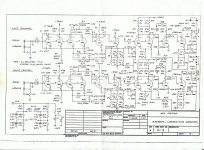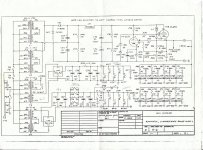Hello. My Lumi has began to produce very high-pitched, faint noise. It starts as soon as I flip the mute off, as soon as it warms up, it sings for about two hrs, then it disappears. It is in both channels, independent of volume control, and is in line section only, very faint but annoying non-the-less. I tried changing tubes, no change. Since it goes away in a couple of hours, am I correct to assume that some caps are gone? Unit is quite old, so it may be a good idea to recap it completely. My film caps are all new, but cans are all original (with exception of phono filament supply). Any thoughts? Thank you.
PS I have schematic diagrams for A-2 and C versions, if anybody is interested.
PS I have schematic diagrams for A-2 and C versions, if anybody is interested.
Sounds like oscillation. Could be power supply caps (or many other things). Is there a regulator?
Sounds like oscillation. Could be power supply caps (or many other things). Is there a regulator?
LOVE your France quote... 🙂
It has tube regulated high voltage, zener regulated phono filaments, but no regulation on line filaments. I tend to think that it has to be recapped...
Is the noise common to both channels?
I love that quote. Kept it longer than I have most of them.
I love that quote. Kept it longer than I have most of them.
Is the noise common to both channels?
I love that quote. Kept it longer than I have most of them.
Yes. what throws me off is that it disappears after a while
If it's in both channels, it's likely to be the regulator or some other power supply function common to both channels. Just out of principle, I'd replace the reg tubes and electrolytics. I'd also look at whatever circuit references the tubes' heaters (especially the pass tube) to a DC potential. Is the reference voltage derived from a Zener or from a VR tube?
If it's in both channels, it's likely to be the regulator or some other power supply function common to both channels. Just out of principle, I'd replace the reg tubes and electrolytics. I'd also look at whatever circuit references the tubes' heaters (especially the pass tube) to a DC potential. Is the reference voltage derived from a Zener or from a VR tube?
I'm not home now, i will have to look at the diagram. VR tube, I beleive, only provides 330v... Zener provides 6.3v, I don't think it is floated at any potential. I have to check.
Thx!
I'm not home now, i will have to look at the diagram. VR tube, I beleive, only provides 330v... Zener provides 6.3v, I don't think it is floated at any potential. I have to check.
Thx!
Sorry, I was unclear. The "reference" voltage I was asking about was for the regulator error amp. Different than the first thing I mentioned, the voltage to which the heaters are referenced (but that's also important).
Sorry, I was unclear. The "reference" voltage I was asking about was for the regulator error amp. Different than the first thing I mentioned, the voltage to which the heaters are referenced (but that's also important).
I will post a diagram later tonight.
High voltage is referenced either by a zener chain, or a 6EJ7 tube circuit there,I don't remember which exactly now. I have replaced the chain once, because one of the diodes died and it started to motorboat.
There were suggestions to float heaters at about 150v. I think that in later versions they are.
Thanks
Mark
Do you have an oscilloscope? And have you replaced the regulator tubes?
As a matter of fact I do! I haven't used it in a few years.
I have replaced every tube, it didn't do anything.
M
OK, excellent, you won't be working blind! Dust it off, then connect a capacitor (value not critical, 0u01-1u0, but it should be 400V or more) to the regulator output. Hook the scope probe on the other end. Turn on the preamp, then see if you can spot the oscillation. If so, we can trace back further. If not, we can start probing around the LV supplies to see if one of them is the culprit.
OK, excellent, you won't be working blind! Dust it off, then connect a capacitor (value not critical, 0u01-1u0, but it should be 400V or more) to the regulator output. Hook the scope probe on the other end. Turn on the preamp, then see if you can spot the oscillation. If so, we can trace back further. If not, we can start probing around the LV supplies to see if one of them is the culprit.
That should be asy - PS has test output on the back. What do we need an additional cap for?
To protect the scope. 300V+ will not do your scope's input much good.
Also, make sure that the test output is actually hooked to the output of the regulator, otherwise, you're not looking at where the action is likely to be.
Also, make sure that the test output is actually hooked to the output of the regulator, otherwise, you're not looking at where the action is likely to be.
To protect the scope. 300V+ will not do your scope's input much good.
Also, make sure that the test output is actually hooked to the output of the regulator, otherwise, you're not looking at where the action is likely to be.
Thank you SY, you've been very helpful. I wil not get to it for a while, dam work... My scope is rated for up to 600v, plus with AC setting and 10x probe you'd think I'd be ok without a cap? I can put one in just in case..
Up to you- for me, it's 20 cents of insurance. 😀
Hello Sy
Just checking in. I have replaced some caps, and am waiting for the rest. I figured it wouldn't hurt to re-cap it, and proceed after...
Thanks
Mark
Excellent. Please keep us in the loop- troubleshooting is interesting and fun when it isn't oneself. 😀
Excellent. Please keep us in the loop- troubleshooting is interesting and fun when it isn't oneself. 😀
I'll echo SY's troubleshooting comment.. 😀 I'm never terribly amused (except perhaps in an ironic sort of way) when it's me doing the trouble shooting, but it is entertaining in a different sort of way. (As in have I passed this way before, and missed something obvious? 😱 )The reward of course is once it's really fixed and you get to listen to it without the annoying realization that something is still broken.. 😛
- Status
- Not open for further replies.
- Home
- Amplifiers
- Tubes / Valves
- MFA Lumi sings high-pitched tunes

